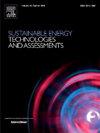Mapping the concentrated solar power development in China: Navigating brief challenges and embracing a bright future
IF 7.1
2区 工程技术
Q1 ENERGY & FUELS
Sustainable Energy Technologies and Assessments
Pub Date : 2025-02-14
DOI:10.1016/j.seta.2025.104228
引用次数: 0
Abstract
We comprehensively evaluate concentrated solar power (CSP) potential in China across four dimensions: geographical, technical, economic, and CO2 mitigation, and extend the analysis from panel to time-series through learning curves and scenario analysis. Evidently, China has substantial CSP potential, with 1.65 million km2 geographical and technical potential mainly concentrated in five provinces: Inner Mongolia, Xizang, Xinjiang, Gansu, and Qinghai. The weighted levelized cost of electricity () of CSP in China is , which is close to grid parity. Provinces should not uniformly progress. Qinghai and Gansu should act as the pioneers, whereas Xinjiang and Inner Mongolia serve as the backbone of the second tier. The grid connection of all ongoing and planned CSP projects is essential for substantial CSP development in China by 2030. In summary, despite the challenges posed by cost competition and evolving market conditions, with strategic advancements, the Chinese CSP industry is poised for a promising future.
求助全文
约1分钟内获得全文
求助全文
来源期刊

Sustainable Energy Technologies and Assessments
Energy-Renewable Energy, Sustainability and the Environment
CiteScore
12.70
自引率
12.50%
发文量
1091
期刊介绍:
Encouraging a transition to a sustainable energy future is imperative for our world. Technologies that enable this shift in various sectors like transportation, heating, and power systems are of utmost importance. Sustainable Energy Technologies and Assessments welcomes papers focusing on a range of aspects and levels of technological advancements in energy generation and utilization. The aim is to reduce the negative environmental impact associated with energy production and consumption, spanning from laboratory experiments to real-world applications in the commercial sector.
 求助内容:
求助内容: 应助结果提醒方式:
应助结果提醒方式:


